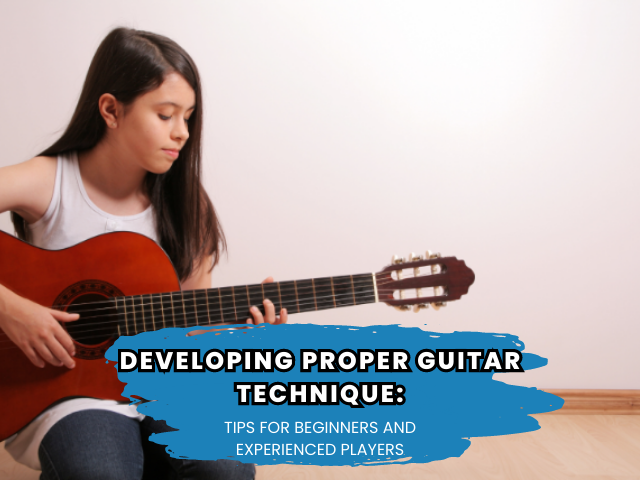
Learning how to play the guitar can be an exciting and rewarding experience. However, mastering proper guitar technique can be challenging and requires time, patience, and dedication. Whether you are a beginner or an experienced player, developing and maintaining good guitar technique is essential for improving your skills and preventing injury. In this article, we will provide you with tips and techniques for developing proper guitar technique.
Table of Contents
- Importance of Proper Guitar Technique
- Basic Guitar Techniques for Beginners
- Advanced Guitar Techniques for Experienced Players
- Common Mistakes to Avoid
- Tips for Maintaining Proper Guitar Technique
- Common Injuries and How to Prevent Them
- The Benefits of Proper Guitar Technique
- Conclusion
- FAQs
Importance of Proper Guitar Technique
Developing proper guitar technique is crucial for musicians of all levels. Proper technique enables players to produce clear and consistent sounds, play more complex music, and avoid injury. Without proper technique, players may experience discomfort, pain, or even permanent damage to their hands and wrists.
Basic Guitar Techniques for Beginners
As a beginner, it is important to establish a strong foundation of basic guitar techniques. These techniques include:
Holding the Guitar
Before you can start playing, you need to learn how to hold the guitar properly. Sit in a comfortable chair with your back straight and the guitar resting on your right thigh (if you are right-handed). Rest your left arm over the guitar’s body and use your thumb to support the neck.
Finger Placement
Correct finger placement is essential for producing clear and accurate notes. Beginners should start by practicing placing their fingers on the frets, making sure each finger is positioned directly behind the fret.
Strumming and Picking
Strumming and picking techniques are fundamental to guitar playing. Beginners should practice strumming and picking the strings with a steady rhythm, using both upstrokes and downstrokes.
Advanced Guitar Techniques for Experienced Players
As you progress as a guitarist, you can start incorporating more advanced techniques into your playing. Book a trial lesson with our esteemed guitar teachers right here if you’d like to see these advanced techniques in action and get some help getting on the right track. These techniques include:
Fingerpicking
Fingerpicking is a technique that involves using your fingers instead of a pick to pluck the strings. This technique allows for more intricate and complex patterns of notes.
Alternate Picking
Alternate picking involves alternating between upstrokes and downstrokes while playing individual notes or chords. This technique allows for faster and more efficient playing.
Sweep Picking
Sweep picking is a technique used to play arpeggios or sweep patterns of notes. It involves using a pick to sweep across the strings in a fluid motion.
Common Mistakes to Avoid
Developing proper guitar technique requires practice, patience, and attention to detail. Avoiding common mistakes can help you improve faster and prevent injury. Some common mistakes to avoid include:
Tension in the Hands and Wrists
Playing with tense hands and wrists can cause discomfort and pain. Make sure to relax your hands and wrists while playing, and take breaks if you start to feel any tension.
Incorrect Finger Placement
Placing your fingers too far from the fret or at an angle can result in inaccurate notes. Make sure to position your fingers directly behind the fret for a clean sound.
Sloppy Strumming and Picking
Sloppy strumming and picking can result in uneven notes and a lack of control over your playing. Practice your strumming and picking techniques slowly and gradually increase your speed.
Tips for Maintaining Proper Guitar Technique
Maintaining proper guitar technique requires consistent practice and attention to detail. Here are some tips to help you maintain proper technique:
Warm-Up Exercises
Warming up before playing can help prevent injury and improve your playing. Simple warm-up exercises like stretching your fingers, wrists, and arms can help prepare your body for playing.
Practice Slowly and Gradually Increase Your Speed
Practicing slowly can help you focus on proper technique and prevent mistakes. Gradually increase your speed as you become more comfortable with the technique.
Take Breaks
Taking breaks can help prevent injuries and reduce fatigue. Make sure to take breaks during long practice sessions and stretch your hands and wrists.
Use a Metronome
Using a metronome can help you develop a steady rhythm and improve your timing. Start by practicing with a slower tempo and gradually increase the speed.
Common Injuries and How to Prevent Them
Playing the guitar can put stress on your hands, wrists, and arms. Common injuries include:
Tendinitis
Tendinitis is inflammation of the tendons and can cause pain and discomfort in the hands and wrists. To prevent tendinitis, make sure to warm up before playing and take breaks during long practice sessions.
Carpal Tunnel Syndrome
Carpal tunnel syndrome is a condition that causes numbness, tingling, and weakness in the hands and wrists. To prevent carpal tunnel syndrome, make sure to maintain proper technique, take breaks, and stretch your hands and wrists.
Repetitive Strain Injury
Repetitive strain injury is a condition that occurs when muscles and tendons are overused, resulting in pain and discomfort. To prevent repetitive strain injury, make sure to warm up before playing, take breaks, and practice proper technique.
The Benefits of Proper Guitar Technique
Developing and maintaining proper guitar technique can provide several benefits, including:
Improved Sound Quality
Proper technique can help produce clear and consistent sounds, making your playing sound better.
Increased Playing Ability
Proper technique allows you to play more complex music and improve your overall playing ability.
Reduced Risk of Injury
Proper technique can help prevent injuries and reduce the risk of developing conditions like tendinitis and carpal tunnel syndrome.
Conclusion
Developing and maintaining proper guitar technique is essential for improving your skills and preventing injury. Whether you are a beginner or an experienced player, practicing basic techniques, avoiding common mistakes, and taking care of your body can help you achieve your goals and enjoy playing the guitar.
FAQs
Q: What is the best way to hold a guitar?
A: Sit in a comfortable chair with your back straight and the guitar resting on your right thigh (if you are right-handed). Rest your left arm over the guitar’s body and use your thumb to support the neck.
Q: How often should I take breaks during practice sessions?
A: It is recommended to take a break every 20-30 minutes to prevent injury and reduce fatigue.
Q: How can I prevent tendinitis and carpal tunnel syndrome?
A: To prevent tendinitis and carpal tunnel syndrome, make sure to warm up before playing, take breaks, and practice proper technique.
Q: What are some common mistakes to avoid while playing the guitar?
A: Some common mistakes to avoid include playing with tense hands and wrists, incorrect finger placement, and sloppy strumming and picking.
Q: What are the benefits of developing proper guitar technique?
A: Developing proper guitar technique can improve your sound quality, increase your playing ability, and reduce the risk of injury.
Developing Proper Guitar Technique: Tips for Beginners and Experienced Players









